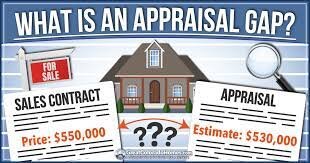In the ever-fluctuating real estate market, buyers and sellers occasionally face a challenging hurdle known as the appraisal gap. This gap arises when a property’s appraised value falls short of the agreed-upon sale price. Understanding why this happens, the possible solutions, and prevention strategies is crucial for anyone navigating a real estate transaction.

What Is An Appraisal Contingency In A Contract?
An appraisal contingency is a clause included in a real estate contract that protects the buyer in the event that the home’s appraised value is less than the agreed-upon purchase price. This contingency allows the buyer to renegotiate the sale price or even back out of the purchase without losing their earnest money deposit if the appraisal does not meet the conditions outlined in the contingency.
Why Does an Appraisal Gap Happen?
Several factors contribute to the emergence of an appraisal gap:
- Market Volatility: In a rapidly appreciating market, prices may outpace the comparative sales data appraisers rely on.
- Limited Comparables: In unique or rural areas, a lack of similar, recently sold properties makes it difficult for appraisers to determine value.
- Condition and Upgrades: Sometimes, a property’s specific conditions or upgrades do not align with the appraiser’s valuation methods.
Possible Solutions to an Appraisal Gap
When confronted with an appraisal gap, parties involved have several avenues to explore:
- Seller Concessions: The seller lowers the price to match the appraised value, facilitating the transaction process.
- Buyer’s Additional Contribution: The buyer can make up the difference out of pocket, a viable option if the property is particularly desirable.
- Splitting the Difference: Both parties compromise, with the seller lowering the price and the buyer bringing additional funds to the closing table.
- Secondary Financing: Buyers might seek a secondary loan or a gift to cover the gap, though this could complicate their financial situation.
- Appraisal Rebuttal: If the parties believe the appraisal is flawed, they can request a review or a second appraisal, hoping for a valuation that closes the gap.
- Renegotiating Terms: Sometimes, renegotiating certain terms of the deal, such as closing costs or timelines, can help bridge the appraisal gap indirectly.
Preventing an Appraisal Gap
While not always avoidable, certain strategies can minimize the risk of an appraisal gap:
- Market Research: Both buyers and sellers should stay informed about local market trends and comparable sales.
- Realistic Pricing: Sellers should work with experienced real estate professionals to set a realistic asking price that reflects the current market and comparable properties.
- Pre-appraisal: Before listing, a seller might consider obtaining a pre-appraisal to gauge the property’s value accurately.
- Appraisal Contingency: Buyers can include an appraisal contingency in their offer, which allows them to renegotiate or back out if the appraisal comes in low.
- Communicate with the Appraiser: Ensuring the appraiser has complete, accurate information about the property and any comparable sales can lead to a more accurate appraisal.
The appraisal gap can be a stumbling block in real estate transactions, but understanding its causes and exploring possible solutions can help buyers and sellers navigate this challenge. With careful planning and open communication, parties can often find a way to bridge the gap, ensuring the transaction moves forward to a successful close.
